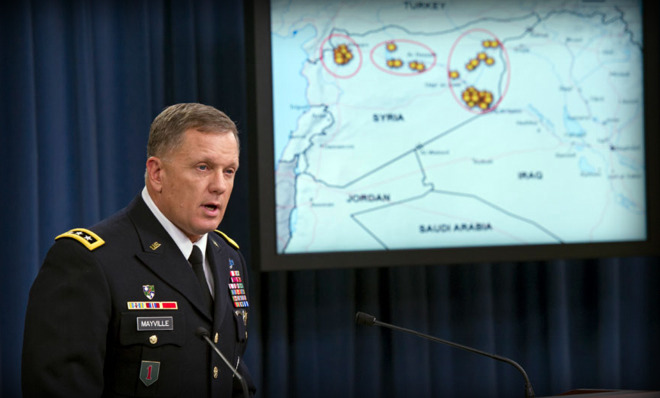Why the Khorasan Group Matters: Part One

The decision by President Obama to carry out airstrikes against the Khorasan Group (also called the Khorasan Shura) and al-Qaeda’s (AQ) affiliate in Syria, Jabhat al-Nusra (or al-Nusra Front), has shifted the conversation over threats to the U.S. from the Islamic State (IS) to AQ.
As discussed by Rita Katz, the Khorasan Group is made up of senior al-Qa’ida members, sent by Ayman al-Zawahiri to Syria in 2012. The Group was working with both bomb makers from of al-Qaeda in the Arabian Peninsula (AQAP) in Yemen and al-Nusra Front to recruit Westerners who would be able to carry out attacks against Europe or the United States. While the precise details of the plot are still sketchy, there are reports that it would entail explosives that are undetectable by current airport security.
It is ironic that the new threat from AQ has appeared just as some within the expert community were deciding that the organization was nearing defeat. A report by ABC News from September 1 is typical, emphasizing that the leadership of the group is “diminished” and “tamped down,” while the affiliates are functioning autonomously from “Core” AQ. The Bipartisan Policy Center, a well-respected think tank with members from across the political spectrum, issued its annual terrorist threat assessment the day after the U.S. strikes against the Khorasan Group, concluding that AQ’s leadership had been “devastated,” lost its sanctuary in Afghanistan, was “facing destruction,” and did not have much control over its own network and behavior of its own affiliates.
But if we take seriously the President’s statement that the Khorasan Group was an “imminent threat” to the United States; believe the words of this Administration’s National Security Advisor, Susan Rice, that the leadership of AQ has “metastasized” into cells around the world; and look at how AQ has been positioning itself over the past few weeks, it seems clear that we are dealing with an AQ that has not been either degraded or strategically defeated.
Three developments, in addition to the imminent threat to the U.S., are particularly troubling: cooperation between AQ affiliates on a level never before seen; the willingness of AQ to even work with its enemies to threaten the U.S.; and the resilience and spread of the affiliates and AQ-linked groups.
The Khorasan Group was working closely with members of both AQAP and al-Nusra Front, precisely the sort of coordination denied by those who see AQ as split into autonomous groups without common direction. Other actions within AQ’s network show that the Khorasan Group’s actions are not a one-off. On September 16, two of AQ’s affiliates, AQAP and al-Qaeda in the Islamic Maghreb (AQIM), put out a joint statement that threatened the U.S. This is unprecedented and a dangerous escalation in the level of cooperation between AQ’s affiliates.

The substance of this particular statement is also telling, since it suggests the potential for reconciliation between AQ and its former affiliate, IS, in order to focus on fighting the U.S. The two have been quarreling for over a year, culminating in their mutual disavowal from earlier this year. Until recently, it has seemed unlikely that the groups would be able (or even willing) to overcome their animosity. The joint AQAP-AQIM statement, however, shows that at least AQ is willing to support IS when attacked by the U.S. The statement condemned the American airstrikes against IS and called, in the face of this “crusade,” for unity among the mujahidin (a reference to the infighting with IS) and for attacks on Americans.
The change in AQ’s willingness to put aside their quarrel with IS is given further support by a new project begun by a large number of AQ-linked ideologues and commanders on October 1. The “Initiative and Call for a Truce Between the [Fighting] Squadrons in Sham,” proposed that all the fighters in Sham (an area that includes Syria, Lebanon, Palestine-Israel, and Jordan) and Iraq unite around “repelling the enemy” and taking on the new “crusade” by the United States. A Twitter page was set up to follow the progress of the initiative, and is constantly updated with new (and generally well-known) jihadists who have given their support to the proposed ceasefire.
It is, in fact, not too much to say that not only is AQ not dead, it is resurgent.
Finally, there have been a series of developments, including the ability of Shabaab to immediately replace its leader—killed in an airstrike—with a new head who declared his support for Zawahiri; the collapse of much of Libya to a mixture of Islamists and AQ-linked groups; the return of AQAP to areas they were expelled from by the Yemeni government two years ago; and the appearance of a new affiliate in the Indian Sub-Continent; that suggest we need to rethink our views of the state of the AQ network as a whole. On their own, each would be significant and troubling, but together, they present a picture of an organization that is resilient and growing, and not the near-spent force suggested by some experts. It is, in fact, not too much to say that not only is AQ not dead, it is resurgent.
